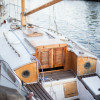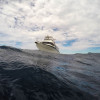Sailboats Explained
Sailboats have many parts and esoteric names, but when you break it down, it isn't all that complicated. Here, we'll make it simple for you by doing just that.
Explore topics
Sailboat types
There are dozens of different sailboat types, all with different names and characteristics. Generally, a sailboat name refers to the sail plan, but not always. We've written a quick guide with real-world examples of 17 different sailboat types and how to recognize them to get you started.
More on sailboat types
Sailboat parts
When you first get into sailing, there are a lot of sailboat parts to learn. Scouting for a good guide to all the parts, I couldn't find any, so I wrote one myself.
In this guide, I'll go over each different sailboat part. And I mean each and every one of them. I'll walk you through them one by one, and explain each part's function. I've also made sure to add good illustrations and clear diagrams.
Sailboats consist of four main segments
- Hull
- Mast
- Sails
- Rigging
The hull is the sailboats' body, which is in contact with the water. The masts hold up the sails, while the rigging attaches the sails to the mast.
Keels
There's a lot to know about sailboat keels, how they function, the different types and their properties, and so on. That's why we've created this detailed cluster to walk you through everything there is to know about sailboat keels. It will link to all different articles on the topic and make it easy to find the exact information you're looking for.
Sail types
Different sail shapes and types are used for different purposes. There are sails for storms and high winds, as well as low wind conditions, like the spinnaker and gennaker. Recognizing the different sail types is the first step to mastering your sailboat's course, handling, and speed.
Rig types
Closely related to sail types are rig types. Rigging is the way the sails are attached to the boat. This means that rigging envelops the mast layout, lines and halyards, and also influences the sails' shapes, and which types will be available to you. We've set out to create a single guide with good diagrams that will give you the complete overview in one read.
Hull types
The hull is the body shape of the boat: the part that floats in or on top of the water surface and provides the boat's buoyancy. While most sailboats use the same hull design, there are many different types, all with different properties. The type of hull affects your boat's performance, handling, stability, and safety. We've created a comprehensive guide that will walk you through all the types, while giving examples of boats using each different hull design.
Explore topics
Sailboat types
There are dozens of different sailboat types, all with different names and characteristics. Generally, a sailboat name refers to the sail plan, but not always. We've written a quick guide with real-world examples of 17 different sailboat types and how to recognize them to get you started.
More on sailboat types
Sailboat parts
When you first get into sailing, there are a lot of sailboat parts to learn. Scouting for a good guide to all the parts, I couldn't find any, so I wrote one myself.
In this guide, I'll go over each different sailboat part. And I mean each and every one of them. I'll walk you through them one by one, and explain each part's function. I've also made sure to add good illustrations and clear diagrams.
Sailboats consist of four main segments
- Hull
- Mast
- Sails
- Rigging
The hull is the sailboats' body, which is in contact with the water. The masts hold up the sails, while the rigging attaches the sails to the mast.
Keels
There's a lot to know about sailboat keels, how they function, the different types and their properties, and so on. That's why we've created this detailed cluster to walk you through everything there is to know about sailboat keels. It will link to all different articles on the topic and make it easy to find the exact information you're looking for.
Sail types
Different sail shapes and types are used for different purposes. There are sails for storms and high winds, as well as low wind conditions, like the spinnaker and gennaker. Recognizing the different sail types is the first step to mastering your sailboat's course, handling, and speed.
Rig types
Closely related to sail types are rig types. Rigging is the way the sails are attached to the boat. This means that rigging envelops the mast layout, lines and halyards, and also influences the sails' shapes, and which types will be available to you. We've set out to create a single guide with good diagrams that will give you the complete overview in one read.
Hull types
The hull is the body shape of the boat: the part that floats in or on top of the water surface and provides the boat's buoyancy. While most sailboats use the same hull design, there are many different types, all with different properties. The type of hull affects your boat's performance, handling, stability, and safety. We've created a comprehensive guide that will walk you through all the types, while giving examples of boats using each different hull design.














